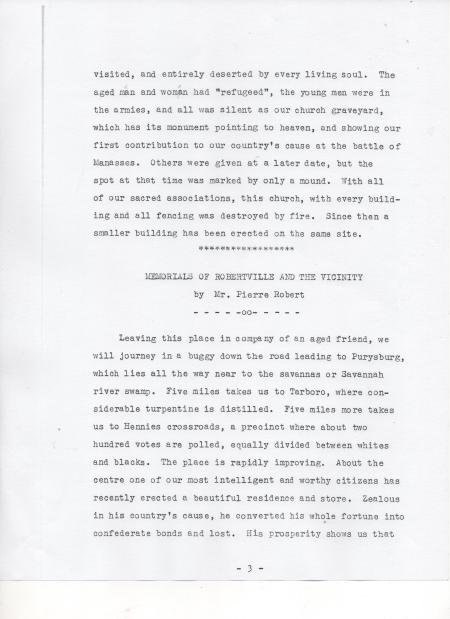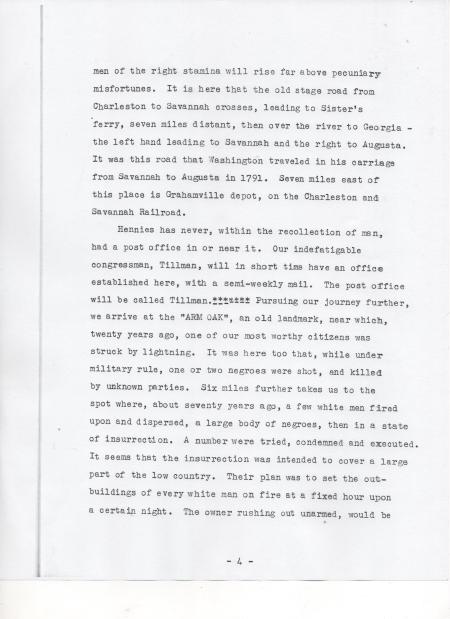(This is the 6th part of a series from a booklet compiled by Ora C. Paul, which is in the archives of the Beaufort County Public Library, Beaufort District Collection.)
MEMORIALS OF ROBERTVILLE, S. C.
by Pierre Robert
(Written for the Hampton Guardian – August 24, 1879)
In a few years we hope to have a centennial celebra-
tion, as this place was settled not long after the
Revolutionary War by the descendants of the Rev. Pierre
Robert, who on account of religious persecution in France,
left his country and with other Huguenots came to this
country, and settled on the Santee, where he was pastor
of the Huguenot church at that place until his death. He
was the first Huguenot preacher in the State.
Our own recollections extend back comparatively a few
years, but at our elbow we have an old resident whose
recollections extend back many years, he having reached the
three score years allotted to man, and to him we listen
and gather facts, as we would from Hume or Gibbon. Previous
to the war the people around this place, with very few ex-
ceptions, were in easy circumstances, many owning plantations,
with from fifty to two hundred slaves, and several as many
as five hundred. Some planters numbered as many as twenty
thousand acres of land in their domain. Their sons and
daughters were educated at the best Southern and Northern
colleges and seminaries. Our village then contained one
small neat Episcopal church and a Baptist church. The
latter was very large, plastered, painted, high-steepled,
had a gallery on three sides, the whole flooring neatly
carpeted, and furnished with an organ. It was built
fifty years before the war (1812), and is said by those
who knew, to have been the best proportioned and the
finest country church in the State. Nearly all the
planters living around, with their families attended this
church. The writer well remembers that during the early
part of the war, when a little boy, his grandfather, being
slightly deaf and a deacon, always sat in the pulpit, and
invariably seated him by his side. ********: Of those I first
remember who were considered advanced in years, but two
now survive. One of these is an old gentleman eighty-five
years of age, who for a long time was a professor in
Charleston College and afterwards President of Furman
College. no one in the State has taught so many of her
citizens. The other is a lady, a widow, now seventy-eight
years of age, who, together with her husband, were always
in latter days the largest contributors to the church. She
has now eighty-two descendants (living). Of the
regular pastors of this church five are now D.D’s, and
there is one each in the States of New York, Pennsylvania,
Virginia, Georgia and Missouri. Of the members of the
congregation and church many are scattered now, and reside
in almost every Southern State of the Union. In the winter
of 1864, during the passage of the vandal army thru the
State, having crossed the river Savannah from Georgia,
only five miles distant, it was the first village they
-2-
visited, and entirely deserted by every living soul. The
aged men and women had “refugeed”, the young men were in
the armies, and all was silent as our church graveyard,
which has its monument pointing to heaven, and showing our
first contribution to our country’s cause at the battle of
Manasses. Others were given at a later date, but the
spot at that time was marked by only a mound. With all
of our sacred associations, this church, with every build-
ing and all fencing was destroyed by fire. Since then a
smaller building has been erected on the same site.
******
MEMORIALS OF ROBERTVILLE AND THE VICINITY
by Mr. Pierre Robert
– – – – -oo- – – – –
Leaving this place in company of an aged friend, we
will journey in a buggy down the road leading to Purysburg,
which lies all the way near to the savannas or Savannah
river swamp. Five miles takes us to Tarboro, where con-
siderable turpentine is distilled. Five miles more takes
us to Hennies crossroads, a precinct where about two
hundred votes are polled, equally divided between whites
and blacks. The place is rapidly improving. About the
centre one of our most intelligent and worthy citizens has
recently erected a beautiful residence and store. Zealous
in his country’s cause, he converted his whole fortune into
confederate bonds and lost. His prosperity shows us that
– 3 –
men of the right stamina will rise far above pecuniary
misfortunes. It is here that the old stage road from
Charleston to Savannah crosses, leading to Sister’s
ferry, seven miles distant, then over the river to Georgia –
the left hand leading to Savannah and the right to Augusta.
It was this road that Washington traveled in his carriage
from Savannah to Augusta in 1791. Seven miles east of
this place is Grahamville depot, on the Charlesotn and
Savannah Railroad.
Hennies has never, within the recollection of man,
had a post office in or near it. Our indefatigable
congressman, Tillman, will in short time have an office
established here, with a semi-weekly mail. The post office
will be called Tillman.******* Pursuing our journey further,
we arrive at the “ARM OAK”, an old landmark, near which,
twenty years ago, one of our most worthy citizens was
struck by lightning. It was here too that, while under
military rule, one or two negroes were shot, and killed
by unknown parties. Six miles further takes us to the
spot where, about seventy years ago, a few white men fired
upon and dispersed, a large body of negroes, then in a state
of insurrection. A number were tried, condemned and executed.
It seems that the insurrection was intended to cover a large
part of the low country. Their plan was to set the out-
buildings of every white man on fire at a fixed hour upon
a certain night. The owner rushing out unarmed, would be
– 4 –
slain by a concealed party and his firearms and horses
procure for their own use. Fortunately for the un-
suspecting whites, the effort made above Purysburg was
premature – one night ahead of the program. A negro,
the property of a planter near by, upon the very night of
the intended attack informed his owner of their intended
plans, and by his timely caution prevented a fulfillment
of them. The faithful fellow was bought by the State and
by a special act freed.
Another miles takes us to the site of old Purysburg,
which is situated immediately on the banks, where the
tide ceases to affect the river, twenty-five miles by
water and eighteen by stage road to Savannah. Purysburg
was settled before Savannah by a colony of Swiss and
Germans under Pury, to whom large baronies of land were
granted by the king of Great Britain. The town was laid
out into lots with streets, and called for himself, Purys-
burg. It was found that large sailing vessels could not
navigate the narrow and crooked river. Freight had to be
carried down nearer to the sea where it could be loaded
for Foreign ports. Horse boats had to be constructed
for this purpose. Large numbers of horses were killed by
this laborious work. The power of steam was then unknown.
The settlement proved unhealthy. Fatal malaria fevers
prevailed, and without that great specific, quinine, were
almost as dreaded as yellow fever. Savannah was soon
– 5 –
after settled. These causes combined soon carried the
town on its downward course, and to-day scarcely ruins
enough remain to show where it stood, tho quite a
quantity of ranging timber, steamboat wood and turpentine
is still shipped from its wharves. A large embankment
still stands with live oaks growing on it, probably thrown
up during the Revolutionary War.
Fifty or sixty years ago a large flat was converted
into a steamboat by one of the enterprising citizens of
Purysburg. It was called the “Cotton Plant”, and ran
regularly for a long time from Savannah to Purysburg – up
one day and down the next. If all the vessels,of every
description, ever built, was moulded into one and came
flying into Charleston, to-day, it would not create more
wonder and amazement than the “Cotton Plant” did to the
good people of Purysburg and the surrounding country upon
her arrival at the wharf. Purysburg has always been noted
for the large number of sturgeon caught opposite the town.
In the spring they seem to collect from the uttermost parts
of the sea. They are not caught with bait, but by fasten-
ing three large iron hooks near the end of a strong cord,
with a heavy sinker at the extreme end, and throwing this
cord from the boat so that the sinker holds it straight
and firm, the fish rubs against the line and always
fastens its flesh in one or more of the three hooks, when
– 6 –
the fisherman hauls his prize into the boat. These fish
are from four to seven feet long. It is said to be fine
sport catching them. If ever opportunity offers the
writer hopes to try his luck at the sport of sturgeon
fishing.
Three miles from this place is the beautiful little
place of Hardeeville, noted for its healthiness and salu-
brious climate. Along the route, the country a mile or
two on the swamp is always healthy.
Two miles further on takes us to the old Hartstein
homestead. The gallant Lieutenant Hartstein was first
brought prominently into notice under the following
circumstances. Previous to the late war the British
government fitted out an expedition to find the long-sought
North-western passage. The commander was compelled to
abandon his vessel and return to England by other means.
About ne year after some Yankees found her drifting in
Bank’s Bay, more than a thousand miles from where she was
abandoned. They took possession and sold her in Britain
as a prize. She was bought by the United States, nicely
fitted up and returned, commanded by Lieutenant Hartstein,
to the English government. Hartstein was afterward made
a commodore in the Confederate service. One mile takes us
where the railroad crosses the Savannah river, the extreme
end of Hampton County. Now we retrace our steps, thinking
over times gone by and the instability of human affairs.
– – – – – oo – – – – –
– 7 –





 *****
*****






























